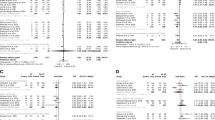Abstract
Nicardipine is a dihydropyridine-type Ca2+ channel blocker with a powerful antihypertensive activity and a unique cerebrovascular profile. Recent studies have examined nicardipine for the treatment of patients with aneurysmal subarachnoid haemorrhage (SAH), but have shown inconsistent results. In the current study, a meta-analysis was performed to assess the clinical effectiveness of nicardipine in the prevention of cerebral vasospasm in patients who had suffered from aneurysmal SAH. Medline, EMBASE, and PubMed databases were searched for the controlled trials evaluating nicardipine for treating SAH after a ruptured aneurysm, without language restrictions. Moreover, a manual search of the bibliographies of relevant articles was also conducted. Two researchers of the present study independently performed the literature search and the data extraction. The meta-analyses were performed using the software RevMan 4.2.10 (provided by the Cochrane Collaboration, Oxford, UK). Five published manuscripts involving 1,154 patients were included in this meta-analysis. Nicardipine infusion reduced the risk of poor outcome (death, vegetative state, or dependency) and mortality, with an odds ratio (OR) of 0.58 [95 % confidence interval (CI) 0.37–0.90] and 0.45 (95 % CI 0.15–1.29), respectively. This meta-analysis suggests that nicardipine therapy reduces the likelihood of poor outcome and mortality in patients after aneurysmal SAH.


Similar content being viewed by others
References
Barker FG II, Ogilvy CS (1996) Efficacy of prophylactic nimodipine for delayed ischemic deficit after subarachnoid hemorrhage: a meta-analysis. J Neurosurg 84:405–414
Barth M, Capelle HH, Weidauer S et al (2007) Effect of nicardipine prolonged-release implants on cerebral vasospasm and clinical outcome after severe aneurysmal subarachnoid haemorrhage: a prospective, randomized, double-blind phase IIa study. Stroke 38:330–336
Dorhout Mees SM, Rinkel GJ, Feigin VL et al (2007) Calcium antagonists for aneurysmal subarachnoid haemorrhage. Cochrane Database Syst Rev 3:CD000277
Epstein BJ, Vogel K, Palmer BF (2007) Dihydropyridine calcium channel antagonists in the management of hypertension. Drugs 67:1309–1327
Haley EC Jr, Kassell NF, Torner JC (1993) A randomized controlled trial of high-dose intravenous nicardipine in aneurysmal subarachnoid haemorrhage. A report of the Cooperative Aneurysm Study. J Neurosurg 78:537–547
Harrod CG, Bendok BR, Batjer HH (2005) Prediction of cerebral vasospasm in patients presenting with aneurysmal subarachnoid hemorrhage: a review. Neurosurgery 56:633–654
Hedges LV (1994) Fixed effects models. In: Cooper H, Hedges LV (eds) The handbook of research synthesis. Russell Sage Foundation, New York, pp 285–299
Huang J, van Gelder JM (2002) The probability of sudden death from rupture of intracranial aneurysms: a meta-analysis. Neurosurgery 51:1101–1105
Kasuya H (2011) Clinical trial of nicardipine prolonged-release implants for preventing cerebral vasospasm: multicenter cooperative study in Tokyo. Acta Neurochir Suppl 110:165–167
Kasuya H, Onda H, Sasahara A et al (2005) Application of nicardipine prolonged-release implants: analysis of 97 consecutive patients with acute subarachnoid haemorrhage. Neurosurgery 56:895–902
Keyrouz SG, Diringer MN (2007) Clinical review: prevention and therapy of vasospasm in subarachnoid haemorrhage. Crit Care 4:211–220
Krischek B, Kasuya H, Onda H et al (2007) Nicardipine prolonged-release implants for preventing cerebral vasospasm after subarachnoid haemorrhage: effect and outcome in the first 100 patients. Neurol Med Chir (Tokyo) 47:389–394
Lee KH, Lukovits T, Friedman JA (2006) “Triple-H” therapy for cerebral vasospasm following subarachnoid hemorrhage. Neurocrit Care 4:68–76
Liu-Deryke X, Rhoney DH (2006) Cerebral vasospasm after aneurysmal subarachnoid haemorrhage: an overview of pharmacologic management. Pharmacotherapy 26:182–203
Raudenbush SW (1994) Random effects models. In: Cooper H, Hedges LV (eds) The handbook of research synthesis. Russell Sage Foundation, New York, pp 301–321
Rinkel GJ (2008) Medical management of patients with aneurysmal subarachnoid haemorrhage. Int J Stroke 3:193–204
Rinkel GJE, Feigin VL, ALGRA A et al (2005) Calcium antagonists for aneurysmal subarachnoid haemorrhage. Cochrane Database Syst Rev 1:CD000277
Sabbatini M, Strocchi P, Amenta F (1995) Nicardipine and treatment of cerebrovascular diseases with particular reference to hypertension-related disorders. Clin Exp Hypertens 17:719–750
Tejada JG, Taylor RA, Ugurel MS et al (2007) Safety and feasibility of intra-arterial nicardipine for the treatment of subarachnoid haemorrhage-associated vasospasm: initial clinical experience with high-dose infusions. AJNR Am J Neuroradiol 28:844–848
van Gijn J, Rinkel GJ (2001) Subarachnoid haemorrhage: diagnosis, causes and management. Brain 124:249–278
Wang J, Ho L, Chen L et al (2007) Valsartan lowers brain β-amyloid protein levels and improves spatial learning in a mouse model of Alzheimer disease. J Clin Invest 117:3393–3402
Weyer GW, Nolan CP, Macdonald RL (2006) Evidence-based cerebral vasospasm management. Neurosurg Focus 21:E8
Zhao XD, Zhou YT, Zhang X et al (2010) A meta analysis of treating subarachnoid hemorrhage with magnesium sulfate. J Clin Neurosci 16:1394–1397
Acknowledgments
We gratefully acknowledge the Guilin 181st Hospital for financially supporting this research. The funding source had no involvement in the research design, collection, analysis, and interpretation of data in writing the report or in the decision to submit the article for publication.
Author information
Authors and Affiliations
Corresponding author
Rights and permissions
About this article
Cite this article
Huang, Rq., Jiang, Fg., Feng, Zm. et al. Nicardipine in the treatment of aneurysmal subarachnoid haemorrhage: a meta-analysis of published data. Acta Neurol Belg 113, 3–6 (2013). https://doi.org/10.1007/s13760-012-0142-x
Received:
Accepted:
Published:
Issue Date:
DOI: https://doi.org/10.1007/s13760-012-0142-x




